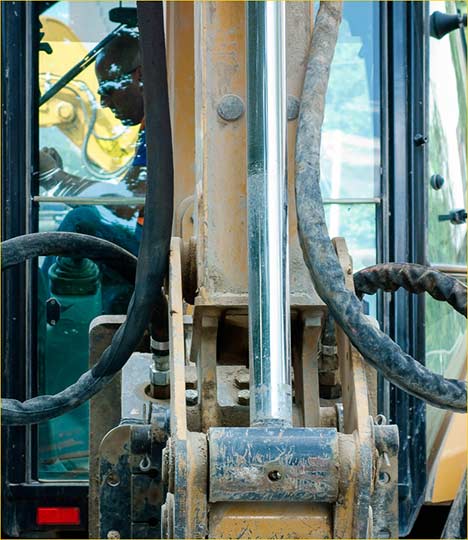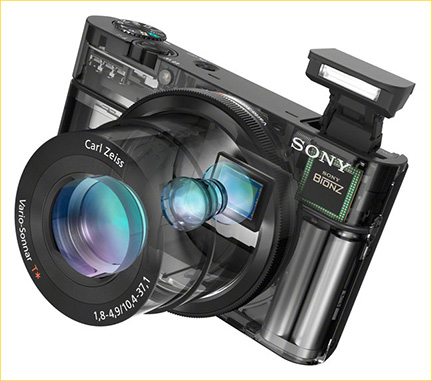
*You might also be interested in the Sony RX100 III Review
The Sony Cyber-shot DSC RX100, to give this camera its full moniker, is Sony’s latest shot across the bow of the camera industry. While they have never been a company to shy from forging new product categories, with the RX100 Sony hasn’t so much created a new category (small camera – large sensor) as they have redefined it.
This is a true pocket camera, even a shirt pocket – or your jeans pocket without a bulge . The sensor is a 1″ CMOS, which makes it as much as 4X larger than a typical point-and-shoot and two to three times larger than its erstwhile competitors, the Fuji X10, Canon S100 and Olympus XZ-1. Only the Canon G1X has a larger sensor, but since that camera is not by any stretch of the imagination a pocket camera I only mention it here for completeness.
Oh yes, did I mention that the RX100’s sensor is 20 Megapixels and that the lens, which fully retracts into the body, is a Carl Zeiss branded 28-100mm equivalent lens with a maximum aperture of f/1.8? Raw? Of course. Optical image stabilization? Ah huh. Video? Yup –1080P at 60P or 50P, depending on region.
The rub? Well, there has to be one, right? The RX100 costs $650 in the US, making it as expensive as an entry level DSLR or CSC. But, smaller these days usually meansmore expensive, not less. That’s what one is paying for; great image quality, a fast aperture and decent focal range, raw, and all in a pocket-sized wonder.
The New York Time’s Personal Technology columnist David Pogue wrote about the RX100 – “No photos this good have ever come from a camera this small“. Let’s see for ourselves is this is indeed the case.
Compromises
Designing any camera entails a series of compromises. Large sensor, small size, fast lens, wide zoom range – all are antithetical to each other. It’s the particular set of compromises that a design team choose to make though that determines a product’s positioning and success.
An example of this is the focal length and aperture range of the lens. It is 28-100mm equivalent and ranges from a maximum of f/1.8 at the wide end to f/4.9 at the long end. Of course going out to 24mm equivalent and having f/4 maximum at the long end would have been icing on the cake, but either would have meant a larger lens, which in turn would have necessitated a large body. Under the design constraints that Sony decided to work with, I find that they did an excellent job of balancing the variables.
Consequently, with the RX100 Sony has clearly decided to push the envelope in the high-end pocketable camera segment and seems to have even broken a few laws of physics along the way. It’s going to leave some of the competition scrambling in the months ahead to catch up.
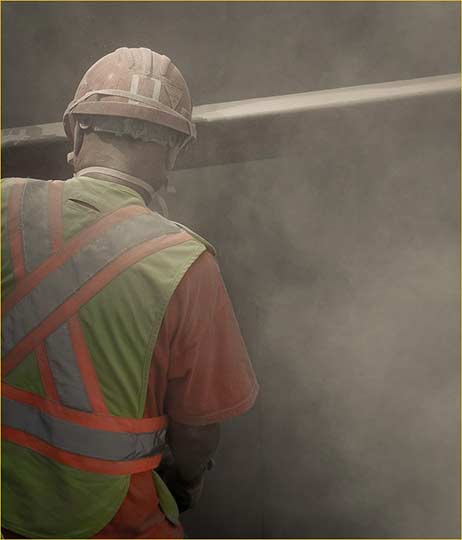
First Impressions
I’m a believer in first impressions. I almost always find that after a half hour or so of familiarization, and a few hours of test shooting, I usually have a strong and reliable impression of how a camera is going to work out over the long haul. In the case of the RX100 my first impression was “wow“, and now after a week or so of use nothing has diminished it.
The “wow” isn’t just hyperbole. It applies to the build quality, the combination of size and functionality, and especially image quality. Let’s see why this is the case.
In Hand
Made in Japan
The RX100 is labeled as “Made in Japan“. This likely goes part-way toward explaining why this camera is premium priced. Most Japanese manufacturers have moved their consumer product manufacturing to places like Thailand, where there is a skilled labour force but lower wages. But, they are reluctant to export the manufacture of their latest or more complex technologies. As a consequence many will perceive the RX100 as a premium product deserving of its premium price.
RAW
The RX100 can shoot raw as well as JPG, but since the camera is so new Aperture, Lightroom and Camera Raw don’t yet support it. Sony’s own Image Data Capture is a raw converter that now supports the RX100. Here is the Mac version for download, and here is the Windows version. Anyone used to a contemporary raw program such as Lightroom or Aperture will roll their eyes in frustration when they try and use Sony’s software, but until Adobe, Apple and others release support it will have to do.
Manual and CD – Not
Yes the words are in the subtitle above, but no, neither is provided with the camera. There is a small multi-lingual getting started guide, but no proper manual, either printed or on CD, and raw software is by download only. What’s with this? Absolutely inappropriate for any sophisticated product let alone one in this price category. Sony should be ashamed of itself for this, just as Olympus should be for charging extra for lens shades. Is there no one at these firms that considers the consequences of customer alienation over such petty items?
Lens Cap
Joy of joys, the dangling lens cap – the bane of small cameras, is not part of this little Sony’s gestalt. The lens is self-capping and when the camera turns off it withdraws almost completely into the camera.
Flash
There is a built-in pop-up flash, similar to the one of the NEX-7. It can be set to OFF, AUTO or manually activated. What is particularly cool is that like the NEX-7’s flash it can be pushed backwards with ones finger so that it acts as a bounce flash. But because the flash’s output isn’t very strong don’t expect to illuminate a room with it, either directly or especially when bounced off the ceiling.
The Mode Dial
There is a well recessed traditional mode dial, and I found it to be firmly detented and unlikely to be moved accidentally when the camera comes in and out of a pocket.
Battery and Charging
The camera uses yet another new battery – of course :-(. Spares should be available when the camera ships in mid-July, unlike with the new Olympus OM-D whose batteries are still unavailable several months after product release. There is no charger supplied, because the batteries charge in-camera using either a USB connection to your computer or the supplied AC charger.
Some photographers find this annoying, because one can’t leave a battery on charge at home or in the car or hotel room while out shooting. Either charge or shoot, but not both at the same time.
A solution would be if an accessory charger were available from Sony, but because this is a new battery not used yet in anything else there is no such product. My solution will be to forgo the $50 for an extra battery. Instead I simply use a generic self-contained portable battery charger which I also use for my cell phone and other small devices.
Digging Waiting. Toronto, July, 2012
Sony RX100 @ ISO 125 (heavy crop)
Screen Display and Menus
Though the RX100 is a diminutive camera its on-screen menus are from Sony’s Alpha series DSLRs and SLTs, not the dreaded NEX series. Actually, Sony has improved the NEX interface since it first appeared, but it’s still a mess. The RX100 has a traditional tabbed layout with seven major sections across the top of the screen, each one divided into multiple single screens, so no vertical scrolling is necessary.
There is a? Helpbutton, but it’s mostly a waste of real-estate and should be allowed to be programmed as a second Custom Button. If pressed while within a menu selection it usually just repeats what the menu says. For example ifAspect Ratiois highlighted the Help button reports “Selects the Aspect Ratio“. This is typical, and mostly useless.
The screen itself is 3” with 1.2M pixel elements, and is able to display a sharp bright image, even in direct sunlight. Like the NEX screens it has Auto brightness, a manual brightness control, and something called “Sunny Weather” which will scorch your eyeballs (and run down the battery fairly quickly).
Live View and Playback screens can be customized to five different display combinations, from image-only to full info, and also a live histogram and electronic level are available. These screens cycle each time the Display button is pressed. My only complaint here is that there are no live highlight and shadow blinkies. These only appear on playback. Olympus can do it, so why can’t Sony.
Features
As with all Sony cameras of the past few years, from DSLRs to point and shoots, the RX100 is loaded with shooting features and gizmos. Sweep panorama is handy, and among the best implementation from any camera maker. There is also HDR bracketing, though alas with the all-too-usual limited exposure range.
Control Ring and Custom Button
Picking up a recent design cue from Canon and others the RX100 has a ring circling the lens that falls directly under ones thumb and forefinger. It can be user programmed for a variety of functions, including exposure variable settings, exposure compensation, and manual focusing.
Unlike some other maker’s implementations, the ring on the RX-100 is not click-stopped. You can optionally have it create an electronic click sound, if you like that sort of thing, but since the ring can take on many different functions, including zooming and focusing as well as exposure control, I don’t find the lack of click stops to be an issue. One just has to be aware of what one is doing.
Manual Focusing
Which brings us to manual focusing. While the RX100 has quite excellent autofocus – as fast as any contrast detection system I’ve used, and with all the multi-point, selectable point, subject tracking and face recognition functions that most cameras these days feature, there are still situations where one wants to use manual focus.
With most small cameras with integral lenses this is problematic. But not with the RX100, for three reasons. The camera offers focus peaking (with selectable colour and sensitivity), there is image magnification in MF mode, and the lens surround ring has proper focusing action. Together these mean that one can easily see the point of focus, confirm its accuracy and then reach it efficiently. If, like me, you program one of the custom buttons (I use the Center) to act as an AF/MF toggle then switching modes and accomplishing accurate and quick manual focus is easily achieved. Nicely done Sony!
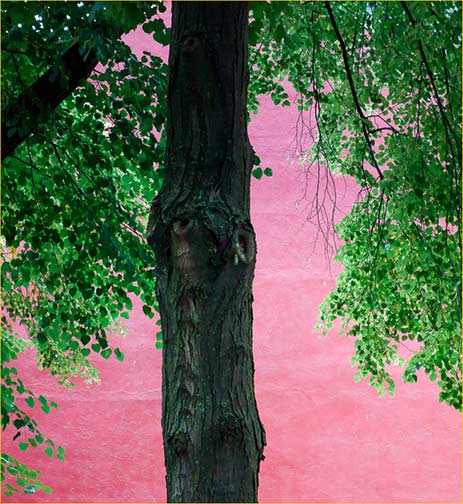
Video
Testing video is a lot harder than testing stills image quality. I’ve been involved in film and video production since my earliest days, and have long come to realize that doing a proper video camera review is a daunting task. But I did do some video shooting with the RX100 and came away pleasantly pleased. Just as its stills image quality belies the camera’s small size so too does its video IQ.
I am planning some video testing of the latest crop of stills cameras and expect to include the RX100, so watch for a report in these pages this summer.
Shooting JPGs During Video
Many cameras advertise that they are able to shoot stills while shooting video. In my experience thus far this is only partially true. Usually the video is halted briefly while the still is recorded, and then it resumes. With the RX100 there is no interruption whatsoever to video recording, but it takes a while for the still image to be saved so that another can be taken, and this only in JPG.
Curiously, though this worked for me during the first few days of testing, when I returned to try this feature for purposes of timing tests it had stopped working and a no-stills possible icon was displayed. Though I spent some time trying various settings to try and ascertain the nature of the problem I could not, If the camera had been supplied with a proper manual I might have been able to, but alas….
Oh yes – did I mention that other than a small pamphlet in multiple languages there is no printed or CD manual available. Remarkable in a $650 camera. Regardless of how small the camera is, it still deserves a manual, don’t you think?
Sensor Size and DOF
Some folks discussing the RX100 online prior to its launch have gotten their knickers in a twist over the issue of DOF and sensor size. Yes – of course a 1″ sensor is going to have greater DOF than a larger sensor at any given image magnification and aperture. But part of the magic of the RX100 is that while its sensor is smaller than APS-C or MFT it’s still respectably large; large enough to provide reasonable DOF even at mid-range apertures and focal lengths.
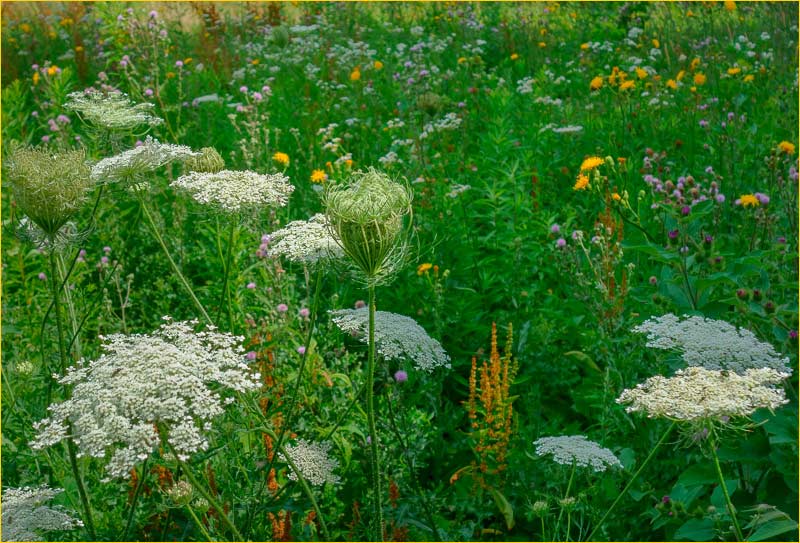
The RX100 has a focal length multiplier of 2.7X over the full frame standard. The above shot therefore was at the equivalent of 46mm in terms of field of view. Since its focal length is an actual 17mm it has the DOF of a 17mm lens, at f/5.6 in this instance. An average focal length, at a mid-range distance and at mid-range aperture.

As can be seen, DOF is limited enough so that foreground and background objects are sufficiently OOF to create a pleasing affect, and certainly without the extremely deep DOF that really small sensor cameras have, and which is commonly one of the factors which can belie an image’s point-and-shoot origins.
Raw, JPG and Image Quality
The camera’s image quality is nothing short of excellent, but my experience so far is that JPG quality is somewhat disappointing, especially at higher ISO. Regrettably, Sony like so many manufacturers, continues with their unnecessary pursuit of proprietary raw formats, and therefore until Adobe, Apple and others can get around to adding raw support we’re stuck with Sony’s Image Data Capture, which can only be charitably described as “barely usable”.
My first couple of days with the RX100 coincided with my being house-bound while recovering from some minor surgery. This restricted my shooting to exciting subjects such as my feet resting on the coffee table, though it was time well spent familiarizing myself with the camera. But, even though not the most aesthetic of subjects (my studio was unavailable), much can apparently be learned from stockinged feet.
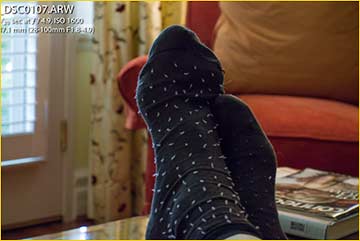
Using a beta version of one of the popular raw converters (life is literally too short for Image Data Capture) what became clear is that especially at higher ISOs JPGs appear to have overzealous noise reduction which strongly reduces resolution. Below are 100% on-screen crops of an ISO 1600 frame. The in-camera JPG is shown as-is while the raw file has had a few seconds worth of manual NR and sharpening adjustments. (An uncorrected raw would obviously tell us nothing of value). The results though speak for themselves.

High ISO
Depending on ones point of view, the nominally 1″ sensor on the RX100 is either quite small, or quite large. For a shirt pocket camera it is large, while compared to APS-C or Four Thirds it’s on the small side.
Below are a series of crops from raw images shot at the full range of ISOs. Basic editing was performed on the raws, and then these settings synchronized, though no noise reduction has been applied.
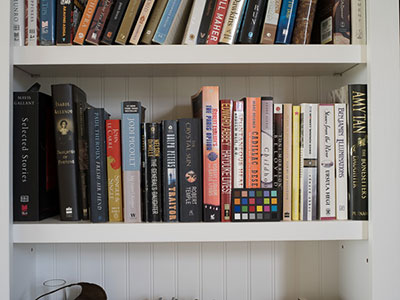






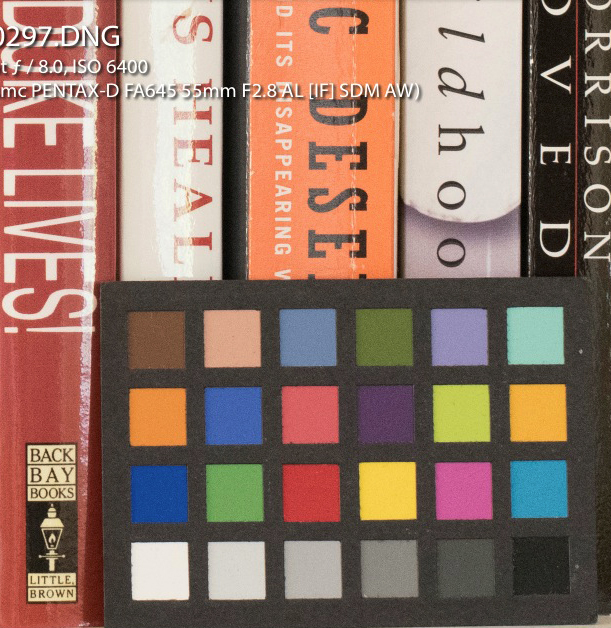
While these are at 100%, keep in mind that this is a 20 Megapixel camera. In 11X17″ prints at a native 300 PPI raw files up to ISO 800 can be used virtually without noise reduction. Use a bit of NR in ones favourite raw processing software and even ISO 3200 files can produce baby bottom smooth large prints, as seen below.
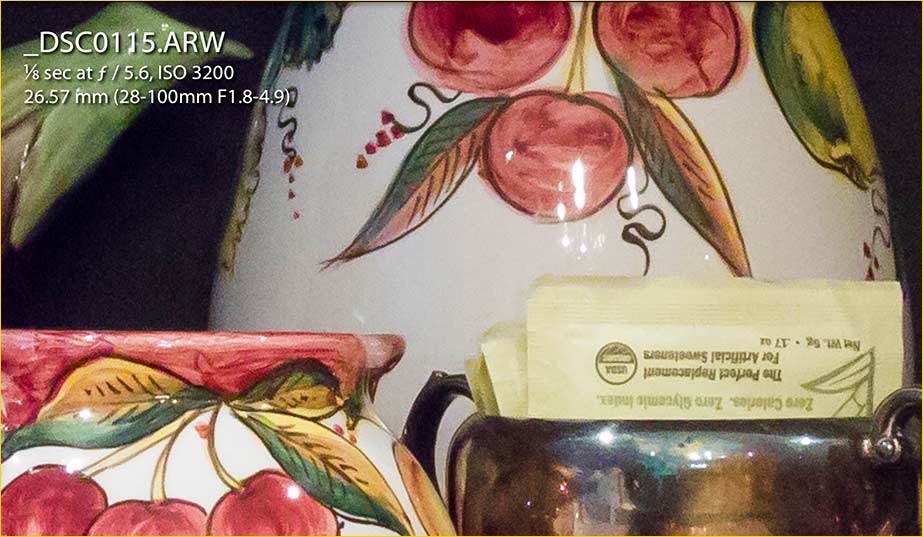
Based on my testing and shooting experience the summary on the RX100 and high ISO noise is that if you’re shooting raw any speed up to and including ISO 800 doesn’t even require any attention. With a slight bit of NR in ones favourite raw processing software up to and including ISO 3200 is perfectly usable, even for large prints.
If you’re shooting JPGs, then the chances are you won’t be making large prints or care all that much about ultimate image quality, so why be concerned?
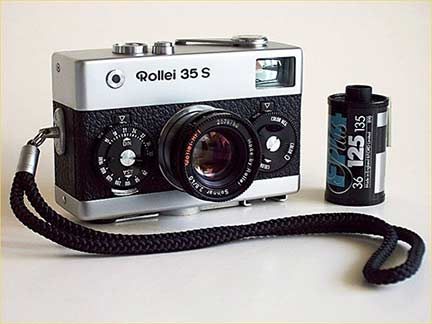
For many photographers of a certain age the Rollie 35 was the ultimate pocket camera. From 1966 till the early 1980’s this camera in its variations wasthe carry-anywhere camera for serious photographers. Since the beginning of the digital revolution we (or at least I) have been looking for a digital Rollei 35 equivalent, and with the Sony RX100 I think I’ve found it. It’s pocketable, full-featured, yet with relative simplicity of use. It has a fast(ish) high quality lens and excellent image quality. Add to this raw, image stabilization, very decent video capability and a high resolution sensor of sufficient size to allow for a quality 13X19″ prints, and though the RX100 and the Rollei are actually as similar as chalk and cheese, they turn out to be soul brothers under the skin.
The summary judgement for me is that the new Sony RX100 is hands-down the most appealing pocket-sized digital camera yet. Capable of producing DSLR grade images, it’s hard to find much to fault with this small pocket wonder. While it is too pricey for many, given that it will almost certainly be a second or even third camera, for demanding quality-conscious photographers looking to own an always-along camera able to produce pro-quality results, the RX100 is not just hard, but for the moment almost impossible to beat.
July, 2012
You May Also Enjoy...
Negative Space
Branch & Shadow — December, 2002Canon 1Ds with 16-35mm f/2.8L @ 35mm. ISO 160Photographs are usually about things, not their absence. But in art there
Ice Art 1
Forbidden City© Miles HeckerCLICK ABOVE IMAGE TO SEE GOOGLE MAP LOCATIONSEASONS In order to get a full appreciation of the ice art one should really
